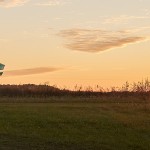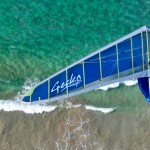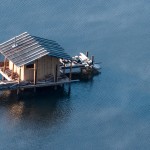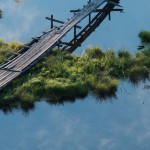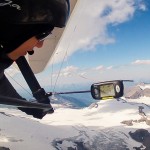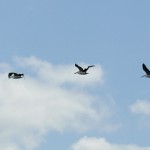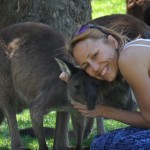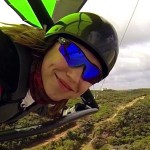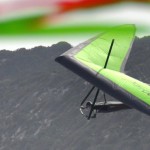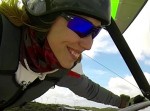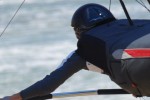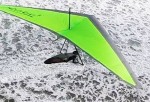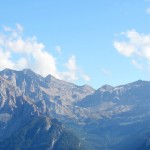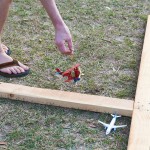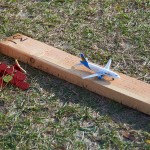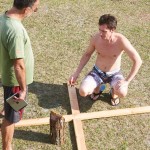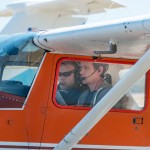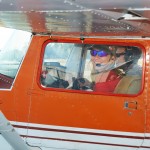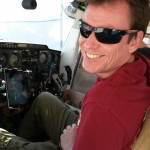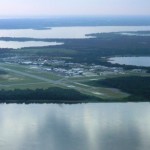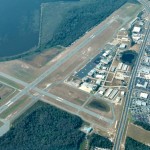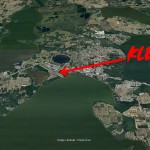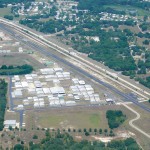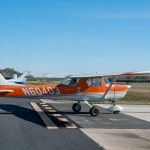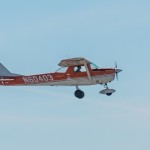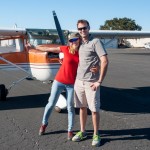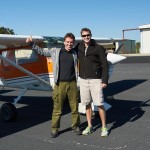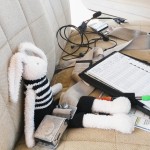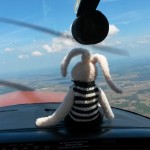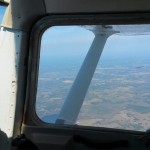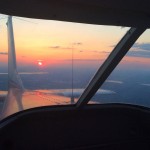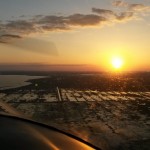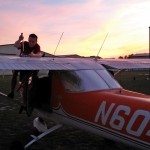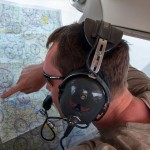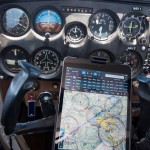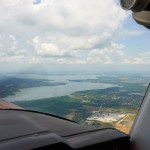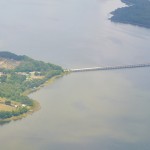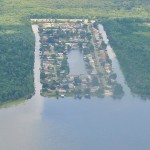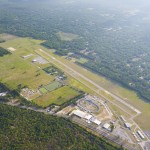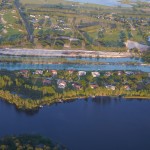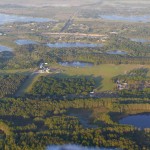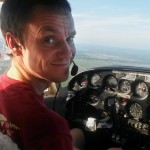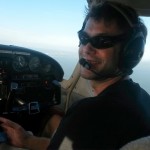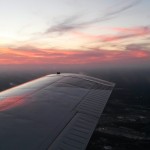How we became private pilots in the United States. Pt.5
Как мы учились в США на частных пилотов. Часть 5
Flight training
Лётная подготовка
Finally, after all this bureaucracy and theory, it’s time to fly!
И, наконец, после всей бюрократии и теории, пришла пора летать!
We were eager to get back into the air and finally see what it was like to fly a general aviation aircraft with an enclosed cockpit and more instruments than we’d ever seen before.
Нам не терпелось подняться в воздух за штурвалом “настоящего” самолёта с закрытой кабиной и непривычно большим количеством приборов.
In addition to the ground school I talked about in my previous entry, there are two more things one can consider doing as a preparation for the flight training: improving English and practicing flying virtually… on PC-based simulators. Let me tell you more about this before I move to the PPL requirements, our flight training progress, and the costs.
Помимо теоретической подготовки, о которой я писала в предыдущей части этого повествования, есть ещё два способа подготовки к учебным полётам: совершенствование своего английского языка и тренировка на виртуальных авиасимуляторах. Расскажу о них, а потом перейду к описанию нашего учебного процесса и его стоимости.
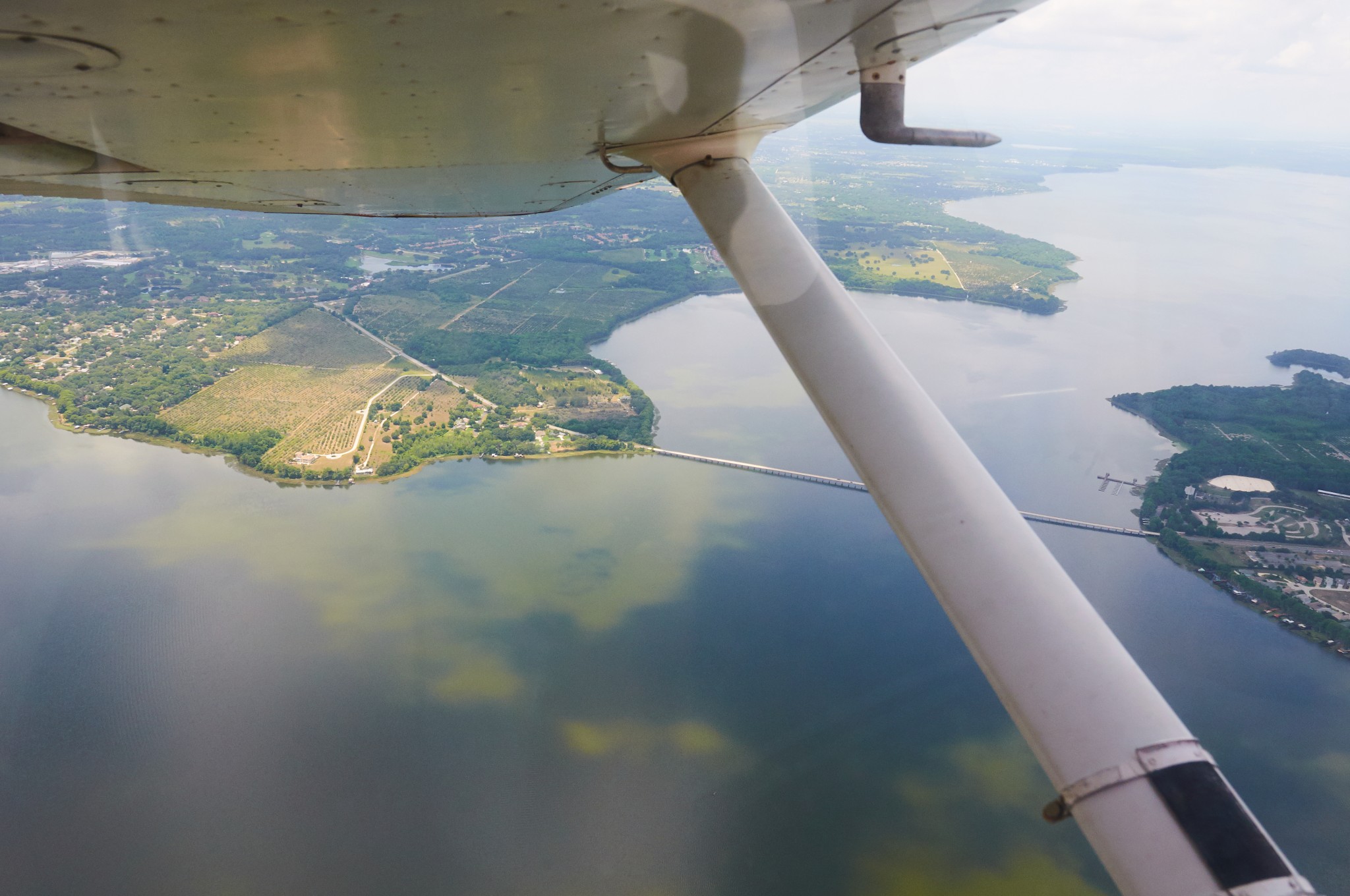
Language skills
Языковые навыки
My English is usually evaluated as Upper Intermediate, while Andrey’s is Intermediate, with listening being his weakest area. For those who are not native to English and have to work hard (like us) to fully comprehend the language, the following things will help:
Мой английский обычно оценивают как Upper Intermediate, а Андрюхин как Intermediate, при этом аудирование у него — самое слабое звено: ему сложно понимать речь на слух. Тем, у кого английский не беглый и не скоро будет (как и у нас), может помочь следующее:
- Before you begin flight training, complete an English-based video ground school course such as Sporty’s or Kings school — I wrote about them in the previous post. If you have mastered a dozen hours of their far from slow speech, this will enhance both your English aviation terminology vocabulary and your ability to successfully deal with your instructor and air traffic controllers. Also, you will have a much better understanding of the theory, which will allow you to avoid being held back by unanticipated gaps in knowledge during the actual flight training.
- Пройденный до начала лётных тренировок видео-курс на английском по наземной подготовке. Например, Спортис или Кингскул — я писала о них в предыдущей части. Если вы осилили пару десятков часов их далеко не медленной речи, навык понимания авиационной терминологии на английском, вашего инструктора и диспетчеров вы явно прокачаете. Да и теорию всю будете понимать, что позволит вам не тормозить с практикой.
- Books and other radio communication materials. I wrote about the book “Say Again, Please” in the previous entry. Radio communication is the weakest link of English-poor students. While at a smaller airport you might be able to say to the control tower “I am a foreign student pilot, please say again… and again…”, it won’t always work with the radar control and flight following. They are often really busy and will more likely just terminate their assistance and suggest you fly VFR.
This is how Andrey and I practiced radio communication with our friend Timothy, making a model of the nearest airport with a control tower (Leesburg; KLEE) and flying toy airplanes. He played the part of the control tower and then critiqued both our verbal responses and the way we “flew” towards the runway he assigned us:
- Книги и другие материалы по радиообмену. Про книгу “Say again, please” я писала в предыдущей части. Вообще, радиообмен — самое слабое звено иностранных студентов. И если вышке в небольшом аэропорту можно сказать “I am a foreign student pilot, please, say again… and again…” (т.е. “Я иностранный студент, пожалуйста, повторите…”), то радарный контроль терпеть не будет — “затерминэйтит”, сказав лететь по VFR самостоятельно.
Вот так мы с Андрюхой и нашим другом Тимати тренировали радиообмен, сделав модель ближайшего к нам аэропорта с вышкой, Leesburg (KLEE), и управляя игрушечными самолётами. Тимати играл роль вышки, прорабатывая все возможные сценарии и проверяя наши ответы:
- Another way to become more familiar with the phrases used and to gain confidence in understanding transmissions is by listening to actual transmissions online. There are many services that allow you to listen to either recordings or live radio communications. It is especially cool to listen and then watch the aircraft track on the flight radar map at the same time: then it’s easier to see what is happening and why.[see links on the sidebar].
- Ещё один способ познакомиться с фразиологией радиообмена — слушать реальный радиообмен онлайн. Есть много сервисов, которые позволяют слушать либо записи, либо радиообмен в реальном времени. Особенно здорово параллельно слушать и смотреть треки самолетов на карте флайтрадара — так понятнее, что и почему происходит.
- It never hurts to make an actual tower visit (preferably accompanied by an instructor or a more experienced pilot) and get to know the actual traffic controllers who might be talking to you in the air. The controllers are very friendly people and usually they go out of their way to help students, particularly when they’ve met them in person. Before we started to fly with our instructor, Timothy took us to the Leesburg control tower so we could meet the traffic controllers with whom we might actually be speaking with later on. They promised to look out for our particular aircraft:
- Не будет лишним сходить непосредственно на вышку (желательно в сопровождении инструктора или более опытного пилота) и познакомиться с диспетчерами. Диспетчеры — очень дружелюбные ребята и стараются помогать курсантам, а если будут знать вас в лицо — и подавно. Еще до того, как мы начали летать с инструктором, наш друг Тимати сводил нас с Андрюхой по очереди на вышку Лисбурга, а милые диспетчеры пообещали за нами приглядывать:
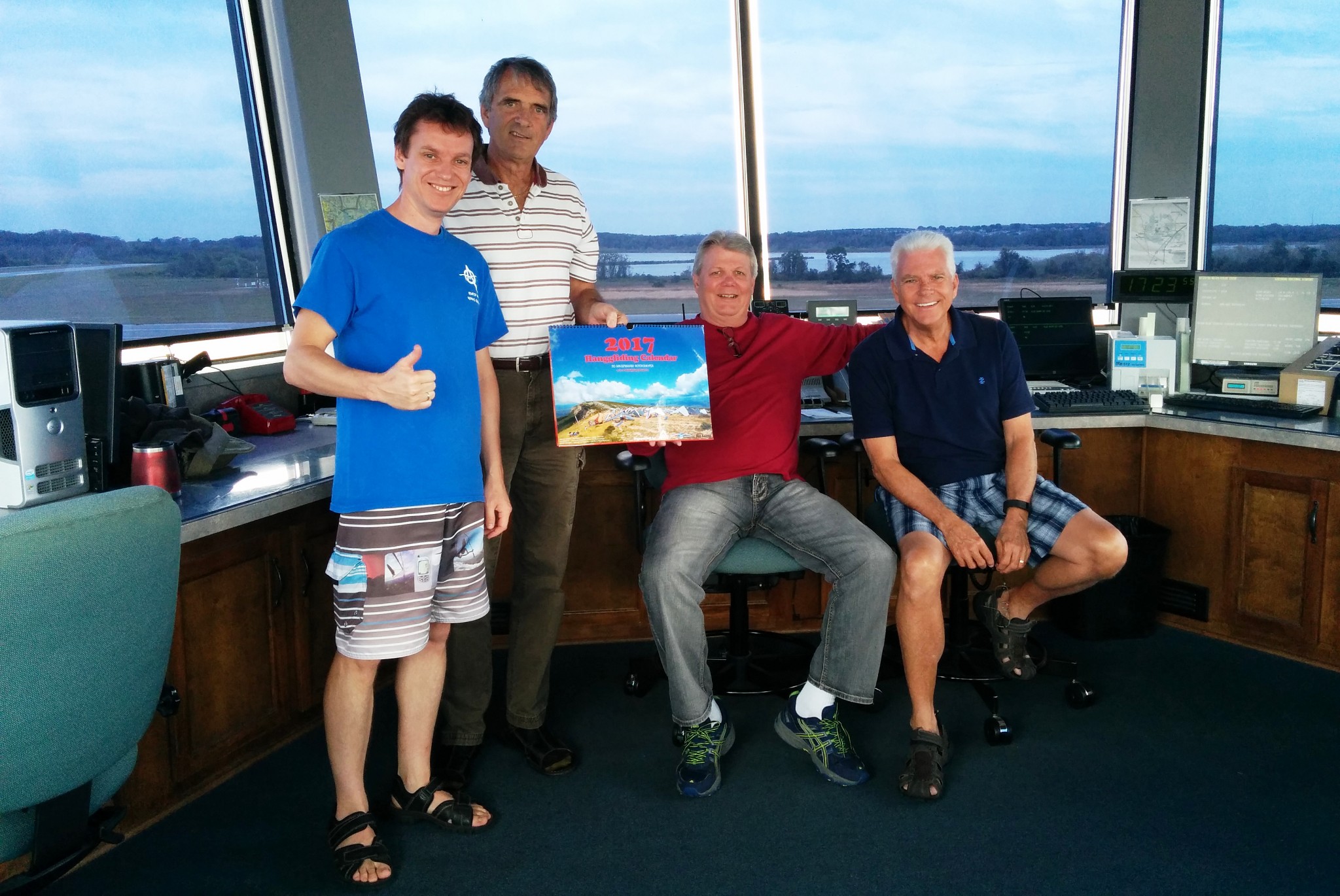
A few weeks later we made our first solo flights in the Cessna there!
Через несколько недель мы вылетели там в наши первые самостоятельные полёты на Цессне.
- To further immerse yourself into the language of aviation, you could also watch the National Geographics series “Mayday” (also known as “Air Emergency”). Watch it in English, of course.
- Из того, что мы не делали, но для фана можно: смотреть сериал от National Geographics “Расследование авиационных происшествий”. На английском, конечно.
Virtual preparation for the flight training
Виртуальная подготовка к лётному обучению
Now a few words about acquiring some piloting skills even before you start flying. For those who are completely new to aviation, virtual flight simulators might be very helpful for preliminary training. Of course, this works only if they are used with the proper approach, instead of mimicking virtual car racing, where people mostly want to drive fast and smash cars.
Теперь что касается лётных навыков. Тем, кто в авиации совсем новичок, для предварительной подготовки очень помогут виртуальные лётные симуляторы. При должном подходе, конечно, а не как в виртуальных автогонках, когда лишь бы погонять и поразбивать машины.
As helpful as they may be, keep in mind that simulators will not give you the true feeling of the airplane. You won’t come to know the actual pressure used on the pedals, or what force has to be applied to the stick, or how the G-loads feel.
Симуляторы не научат непосредственно пилотированию в смысле чувствования самолёта: насколько нажать педаль, с какой силой отдать ручку, как отреагировать на перегрузку.
Instead, simulators will you give an understanding of how the aircraft behaves in the air, what forms of movement are there, and with what dynamics those movements develop. Using them will allow you to experience how quickly the plane can gain and lose speed, how much altitude you might lose in a 180 degree turn back to the airport with a dead engine right after take off, and how the approach to landing can evolve in different ways each time. You should end up with a good understanding of the general physics behind the true feel of an aircraft in flight.
Но они дадут понимание того, как самолёт ведёт себя в воздухе, какие формы движения бывают, с какой динамикой эти движения развиваются, как быстро самолет может набирать и терять скорость, что будет происходить в развороте, что будет происходить при заходе на посадку. В общем, может сложиться хорошее представление об общей физике поведения самолета в воздухе.
Simulators also help with learning how to fly using the instruments. They teach two important skills: both distributing and prioritizing attention. You can to learn how to scan the instruments in the optimal order while mentally building a complete picture of what is happening with the aircraft and what will happen next. Later you will have to learn this on a real plane anyway, and if you are already familiar with this, it will be much easier for you in real life. Also, in the virtual simulators you can learn navigation, and in some simulators, even radio communication.
Симуляторы помогают научиться пилотированию с использованием приборов. Они учат двум важным навыкам: распределению внимания и переключению внимания. Пробегать взглядом по приборам в оптимальном порядке, строить целостную картину того, что происходит с самолетом и что будет происходить — если вы уже будете это уметь до начала полетов, вам будет гораздо проще первый раз в воздухе. Вы можете обучаться навигации, а в некоторых симуляторах даже радиообмену.
Here’s a few examples of flight simulators available online.
Какие есть виртуальные симуляторы:
- Microsoft flight simulator. It was not supported yet still popular for many years, and now they are promising to release a new version. This simulator has a flying course with an exam at the end, which is similar to the PPL course!
- Microsoft Flight Simulator. Долгое время был устаревшим, но всё равно популярным, а сейчас они готовят к выходу новую версию. В MSFS есть виртуальный курс пилотирования, похожий на реальный курс для частного пилота, и можно даже сдать виртуальный экзамен!
- Xplane11 and PREPAR3d — two more general aviation simulators. Out of modern simulators, they are probably the closest possible simulation of general aviation flights, especially in the United States. They, too, include almost all of the US airports. You can fly well-known Cessnas and Pipers.
- Еще из гражданских — Xplane11 и Prepar3d. Это современные наследники MSFS, имитирующие полёты гражданской авиации, особенно на территории США. Там тоже есть все аэропорты, можно летать на привычных Цесснах и Пайперах.
- “Rise Of Flight” (free to play!) and Il2-Sturmovik (its new version) — combat flight simulators with much more realistic dynamics of flight, aerodynamics and piloting. Andrey, by the way, is one of the developers of these two games.
- Если хочется прочувствовать более реальную динамику полёта, аэродинамику и нюансы пилотирования, то это симуляторы Rise Of Flight (бесплатный!) и Ил2-Штурмовик (его новая версия). Андрей, к слову, является одним из разработчиков двух последних игр.
Of course, you will need a joystick and pedals to properly fly on simulators, not just a keyboard. But compare their cost with the cost of the actual air time: pedals cost around $130-150, while a joystick cost can vary from $20 to $350 dollars. Compare this cost to the real expense of renting an airplane! Furthermore, this equipment will be yours forever.
Конечно, летать на симуляторах надо не с клавиатуры и мышки, а с педалями и джойстиком. Сравните их стоимость со стоимостью обучения на реальном самолёте: педали — 130-150 долларов, джойстик — 20-350 долларов. Переведите это в стоимость реальных лётных часов, и помните также, что это оборудование останется у вас дома навсегда.
With such preliminary self-training on a simulator, once you get into a real plane, you will only have to add three aspects:
После такого самообучения на симуляторе попадая в реальный самолёт вам останется только сложить три аспекта:
- panoramic view (only if you did not fly on a simulator in a VR helmet. If you did fly wearing one, then you are already half a pilot);
- панорамный обзор вокруг (если только вы не летали на симуляторе в шлеме виртуальной реальности. Если летали в нем, то вы уже наполовину пилот!);
- the feeling of G-loads;
- ощущение перегрузок;
- the forces needed to move the controls and their resistance back.
- c какими усилиями и расходами работать рычагами управления.
Everything else can be learned on a simulator. Use it if you want to save money!
Всё остальное можете изучить на симуляторе. Хотите сэкономить — пользуйтесь.
I did not train on simulators at all. Andrey, on the other hand, has thousands of hours flying in many different virtual simulators. That’s probably why he learned to fly an actual aircraft several times faster than I did.
Я не летала на симуляторах, а у Андрея — тысячи часов налета на виртуальных самолётах. Он научился летать на реальном самолете в несколько раз быстрее меня.
The experience required for a PPL
Лётные требования к частному пилоту
The total number of logged flying time a student must have to obtain a Private Pilot License learning under FAR Part 61 (more on Parts 61 vs 141 in the second entry) is a minimum of 40 hours, which must include at least:
Минимальный налёт, который должен иметь студент для получения лицензии частного пилота в США при обучении по 61-му параграфу Федеральных Авиационных Правил (о параграфах больше во второй части) — 40 часов. Из них:
— Dual: At least 20 hours of instruction with a CFI including:
— Минимум 20 часов налёта с инструктором, включая:
- three hours of cross country flight training;
- three hours of night flight training which includes at least:
— one cross country flight of over 100nm total distance; and
— 10 takeoffs and 10 landings to a full stop with each involving a flight in the traffic pattern at an airport. - three hours of flight training by reference to instruments; and
- three hours of flight training within the 60 days prior to the practical test.
- три часа маршрутных полётов;
- три часа ночных полётов, включая
— один ночной полёт общей дистанцией более 100 морских миль и
— десять ночных взлётов и посадок с полной остановкой и полетами по кругу; - три часа полётов по приборам;
- три часа подготовки к экзамену обязательно в течение 60 дней перед экзаменом.
— Solo: 10 hours minimum of solo flying including:
— Минимум 10 часов самостоятельного налёта, включая:
- three takeoffs and landings to a full stop at an airport with an operating control tower;
- five hours of solo cross country flying including one solo cross country flight of at least 150nm total distance with full stop landings at three points and one segment of at least 50nm between takeoffs and landings.
- три взлёта и посадки до полной остановки в аэропорту с вышкой;
- пять часов маршрутных полётов, включая один полёт общей дистанцией 150 морских миль с тремя посадками по пути, при этом один из перелётов должен быть не менее 50 морских миль прямой дистанции.
It would seem that only 3+3+3+3+5 = 17 hours need to be flown to fulfill the minimum requirements for the specified exercises. The 100 mile night flight with an instructor, however, will be also counted as part of the three hours of required cross country flights, and this will take at least an entire hour (if you fly at the speed of Cessna 150). One hour of night flight training can also be combined with the instrument flight training. All types of landings (whether at night or with a control tower) can be planned as a part of the required cross country flights. If all the training takes place a couple of months before the exam, then the three hours of preparation for the exams are automatically obtained.
Казалось бы, 3+3+3+3+5 = 17 часов минимум уйдёт на заполнение этих обязательных граф в лётной книжке. Но ночной маршрут с инструктором на 100 миль засчитается и в три требуемых часа маршрутных полётов, а это целый час (если лететь со скоростью 150-й Цессны). Час ночных полётов можно объединить с полётами по приборам, а все виды посадок (ночных или с вышкой) надо планировать в рамках требуемых маршрутных полётов. А если всё ваше обучение в принципе происходит за пару месяцев перед экзаменом, то три часа подготовки к экзаменам как бы получаются автоматически.
Thus, the required entries in the log book could conceivably only take, say, 2+3+2+5 = 12 hours.
Таким образом, на обязательные графы в лётной книжке может уйти, скажем, 2+3+2+5 = 12 часов.
What is a student supposed to do for the remaining 40-12 = 28 hours? This is not specified in the airtime requirements, but it is all listed in the Airman Certification Standards.
Чем же предполагается заниматься оставшиеся 40-12= 28 часов? В требованиях к налёту это не указано, но зато всё это перечислено в Airman Certification Standards.
Long story short, for a flight exam, a future private pilot should be able to show:
Если кратко, на лётном экзамене студент должен показать:
- Normal, soft field, and short field departures.
- Взлёты: обычный, имитация взлёта с короткой полосы и с “мягкой” полосы (раскисший грунт).
- Normal, soft field and short field approaches and landings. Landing without flaps is optional.
- Посадки: обычная, имитация посадки на короткую полосу и на раскисший грунт. Посадка без выпущенных закрылков факультативна.
- Power-off stalls. Power-on stalls. Spin awareness.
- Сваливание на взлётном режиме (на полном газе), сваливание с задросселированным двигателем. Действия по предотвращению попаданию в штопор.
- Maneuvering during slow flight.
- Маневрирование на минимальной скорости.
- Steep turns.
- Глубокий вираж.
- Ground Reference Maneuvers: rectangular course, S-turns, turns around a point.
- Манёвры по наземным ориентирам: коробочка, S-образные развороты, полёт по окружности вокруг точки.
- Emergency operations. Engine and other aircraft systems failure simulations at different stages of flight.
- Имитации отказа двигателя или других систем самолёта на разных этапах полёта.
- Recovery from unusual flight attitudes (which are introduced by your instructor while you have your eyes shut).
- Вывод самолёта из сложного пространственного положения (в которое заранее вгоняет его инструктор/экзаменатор, в то время как вы ничего не видите).
- Navigation, basic instrument maneuvers, etc.
- Пересчет маршрута на ходу, полёт по приборам и т.д.
Of course, it is also necessary to properly execute the numerous pre-flight procedures, traffic patterns, touch-and-goes, go-arounds, crosswind landings (which came in handy on our check ride!), and postflight procedures. All this, of course, while performing airport operations, navigation, radio communication, holding the altitude within +/- 100 feet (33 meters) and the speed within +10 and -5 knots (sometimes -10, and sometimes -0! — depending on the maneuver).
И, конечно, надо хорошо делать многочисленные предполётные процедуры, базовые набор-горизонт-снижения, скольжение на посадочной глиссаде, посадки с боковым ветром (нам пригодилось на экзамене!), конвееры, уходы на второй круг, коробочки, послеполётные процедуры. И всё это, естественно, поддерживая навигацию, радиообмен, высоту обычно +/- 100 футов (33 метра), скорость +10 и -5 узлов (иногда и -10, а иногда -0! — в зависимости от манёвра).
There is a specified procedure one has to learn and master for each of these maneuvers. It turns out that even if you are already familiar with some other form of flight as begin your flight instruction, and may have even soloed something, you still are likely to need more than 40 hours to be fully prepared for the check ride.
Для каждого из манёвров существует очередность действий, которую надо выучить и хорошо отработать. И получается, что даже если к началу лётной практики вы не совсем новичок в авиации и может даже на чём-то как-то умеете летать, эти 40 часов уйдут просто на то, чтобы хорошо подготовиться к экзамену!
According to the FAA, the average time for preparing a beginner for the PPL exam is 60-65 hours of air time. And I believe that! After all, in addition to all the maneuvers and procedures I have mentioned, it is necessary at some point to actually just learn how to fly a plane. To feel the joy of having “danced the skies on laughter-silvered wings” for your very first time, as well as experiencing the delight of the first solo flights! That takes more than just an hour or two.
А среднее время подготовки новичка к экзамену на PPL, по данным FAA, составляет 60-65 часов. Охотно верю! Ведь помимо всех манёвров и процедур надо когда-то вообще-то успеть и просто управлять самолётом научиться. Весь этот кайф обуздания стального мотора и восторг первых самостоятельных полётов! Это же не за час-два делается.
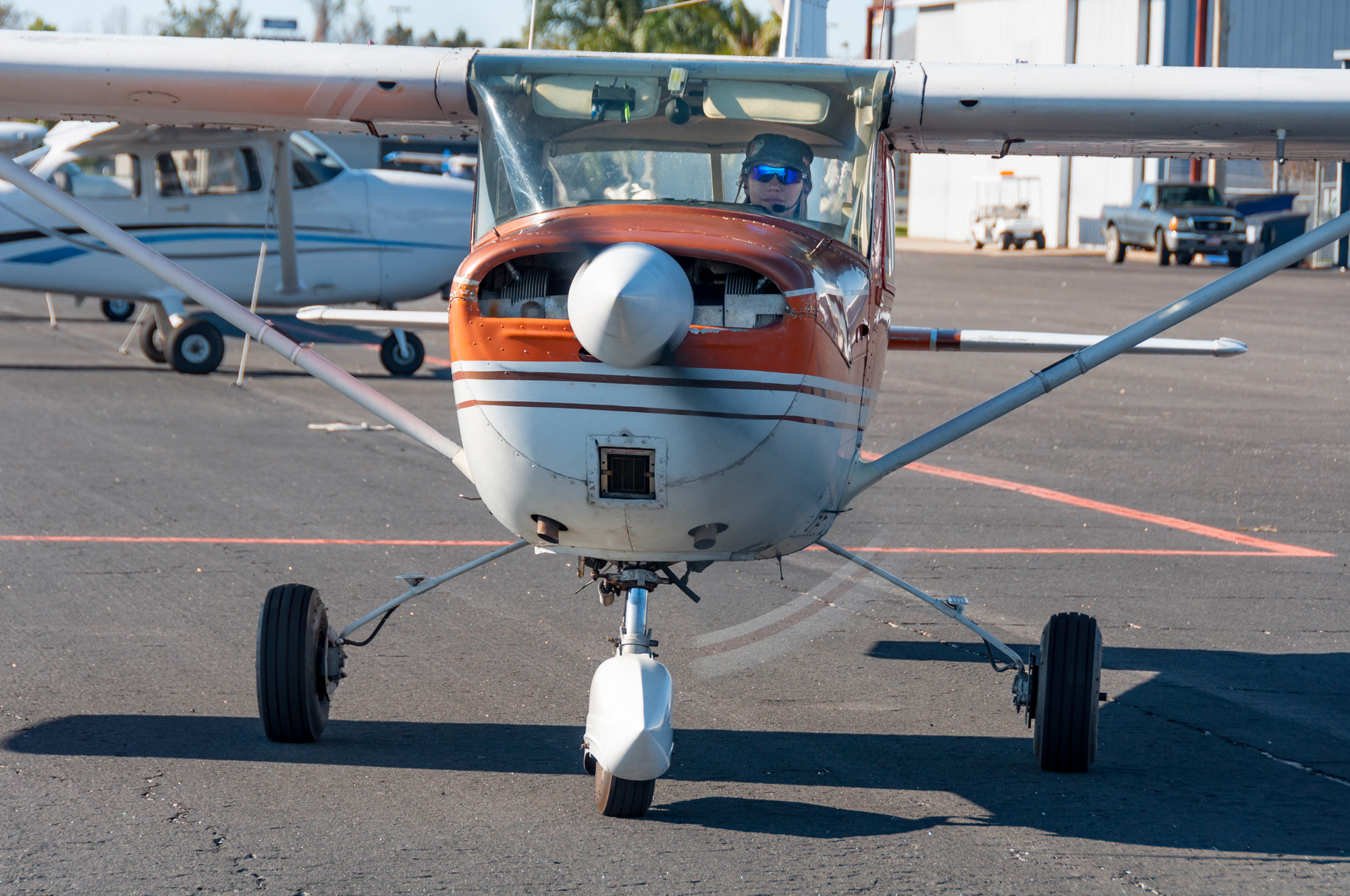
Even so, we still managed to complete the program in a little less than 40 hours, but then took a few more hours of flying with our instructor Jason on two other airplanes:
В принципе, мы с Андрюхой справились с программой чуть меньше даже, чем за 40 часов, но потом взяли еще несколько часов полётов на самолётах:
- A Piper Cherokee with an engine of more than 200 horsepower (for a High Performance endorsement);
- A Dragonfly (for a Tailwheel Endorsement).
- Piper Cherokee с двигателем более 200 лошадиных сил — для получения High Performance endorsement;
- Dragonfly — он с хвостовым колесом и даёт возможность получения Tailwheel endorsement.
As a result, by the time of the exam, Andrey and I had 41.9 and 42.4 hours airtime, respectively. First of all, our priority was to try really hard to master the program in the minimum number of hours, as we did not want to spend any more than we absolutely needed to.
В итоге, к моменту экзамена у меня и Андрея было по 41.9 и 42.4 часа налёта соответственно. Но! Во-первых, мы очень очень старались уложиться в минимальный налёт — тогда нам не хотелось тратить лишних денег.
Secondly, we already knew how to fly a Dragonfly — an airplane, albeit one with an open cockpit and almost no instruments required, but still an airplane with three-axis controls like the Cessna we’d eventually use for our PPL.
Во-вторых, мы уже умели летать на Драгонфлае — самолёте хоть и с открытой кабиной и практически без приборов, но всё же самолёте с аэродинамическим управлением.
Also, we have been hang glider pilots for many years, and although it is a completely different type of piloting, even hang gliding experience helps and accelerates mastering an airplane. Our instructor used to say that the hardest part of being a flight instructor is to teach a beginner how to stay ahead of aircraft, to have the appropriate balance between confidence and caution, and to take responsibility for their decisions — therefore, any aviation experience is beneficial.
К тому же, мы много лет летаем на дельтапланах, и хотя там совсем другой тип управления, даже дельтапланерные полёты помогают и ускоряют осваивание самолёта. Наш инструктор говорил, что сложнее всего приучить новичка к лётной осмотрительности, научить соображать в полёте, просчитывать варианты развития событий, брать ответственность за свои решения, — поэтому любой авиационный опыт идёт на пользу.
Our tips for improving flight training efficiency
Наши советы по повышению эффективности лётной практики
The following may seem straightforward but every little bit helps.
Всё очевидно, казалось бы, но не все почему-то это делают.
- Study the map of the area where you will fly. Learn it, remember it. All the roads, lakes, rivers, cities, and their distances from the airfield. You’ll need to be able to quickly navigate in the air at any given time.
- Изучите карту окрестностей, где будете летать. Все эти дороги, озёра, города, расстояния от них до аэродрома — чтобы быстрее ориентироваться в воздухе в каждый момент времени.
- Always have a notebook with you, and write down everything your instructor says. Reread it all when you are back home.
- Ходите с блокнотом, записывайте всё, что говорит инструктор. Перечитывайте дома.
- Analyze the weather, check NOTAMs and calculate the route in the morning, on your own.
- Самостоятельно с утра проводите анализ погоды, расчет маршрута и т.п.
- Learn in advance all phases of all required maneuvers, then play them in your head along with the movement of your arms and legs when you are home.
- Выучите заранее дома этапы выполнения всех требуемых манёвров, проигрывайте их вместе с движением рук и ног.
- Find a companion and simulate the radio communication as much as possible.
- Найдите компанию и имитируйте радиообмен как можно больше.
How the flight training progresses
Как происходит лётная подготовка
Demo flight
Ознакомительный полёт
Training begins with a demo flight. Instructors are even specially taught how to make such a flight: in smooth conditions, preferably to another airport (such as a nice place on the coast!) to show the ease of moving by air compared to other kinds of transport. With such a positive approach, the focus is on safety and enjoyment instead of possible failures and constant anticipation of emergency landings. In general, they try to induce you into an addiction to flight.
Обучение начинается с ознакомительного полёта. Инструкторов даже специально учат, как правильно делать такой полёт: в несложных условиях и желательно в другой аэропорт (в симпатичном месте на побережье!), чтобы показать лёгкость передвижения по воздуху по сравнению с другими видами транспорта. С «позитивным подходом», акцентируя внимание на безопасности и приятности, а не на возможных отказах и готовности к экстренным посадкам. В общем, стараются подсадить на иглу авиации.
Due to the fact that Andrey and I already knew how to fly a Dragonfly, our instructor Jason did not waste time on trying to convince us to fully dive into the experience. We were already devoted disciples to this kind of heaven.
В силу того, что мы уже умели летать на Драгонфлае, наш инструктор Джейсон не стал тратить время на демонстрации (мы сами кого угодно могли подсадить на небесный наркотик).
We went through a pre-flight inspection of our (for now) Cessna 150, covered some airport procedures, taxied to the runway (with me in the left seat right away), and then Jason said: “Take off!”
Мы прошлись по предполётному осмотру нашей Цессны-150 и аэропортовым процедурам, выехали на взлётку (я сразу в левом кресле), и Джейсон сказал: “Взлетай!”
“Hmmm,” — I said, — “but I have never flown an airplane with an instrument panel, flaps, mixture control, carburetor heat, and all that. I just don’t really know how to take off using all of this.”
“Ээээ”, — сказала я, — “а я же никогда не летала на самолёте с приборной доской, с закрылками, управлением смесью, подогревом карбюратора и вот всем вот этим. Я же не знаю, как взлетать-то”.
Let me explain. The instrument panel of a Dragonfly looks like this, and with experience you don’t even need to look at the air speed indicator (the vertical tube on the left) on the take off, because this plane can easily be piloted solely by the seat of your pants.
Поясню, что приборная доска на Драгонфлае выглядит так, и я даже на указатель скорости (вертикальная трубка слева) не всегда смотрю на взлёте — этим самолётом можно управлять по ощущениям:
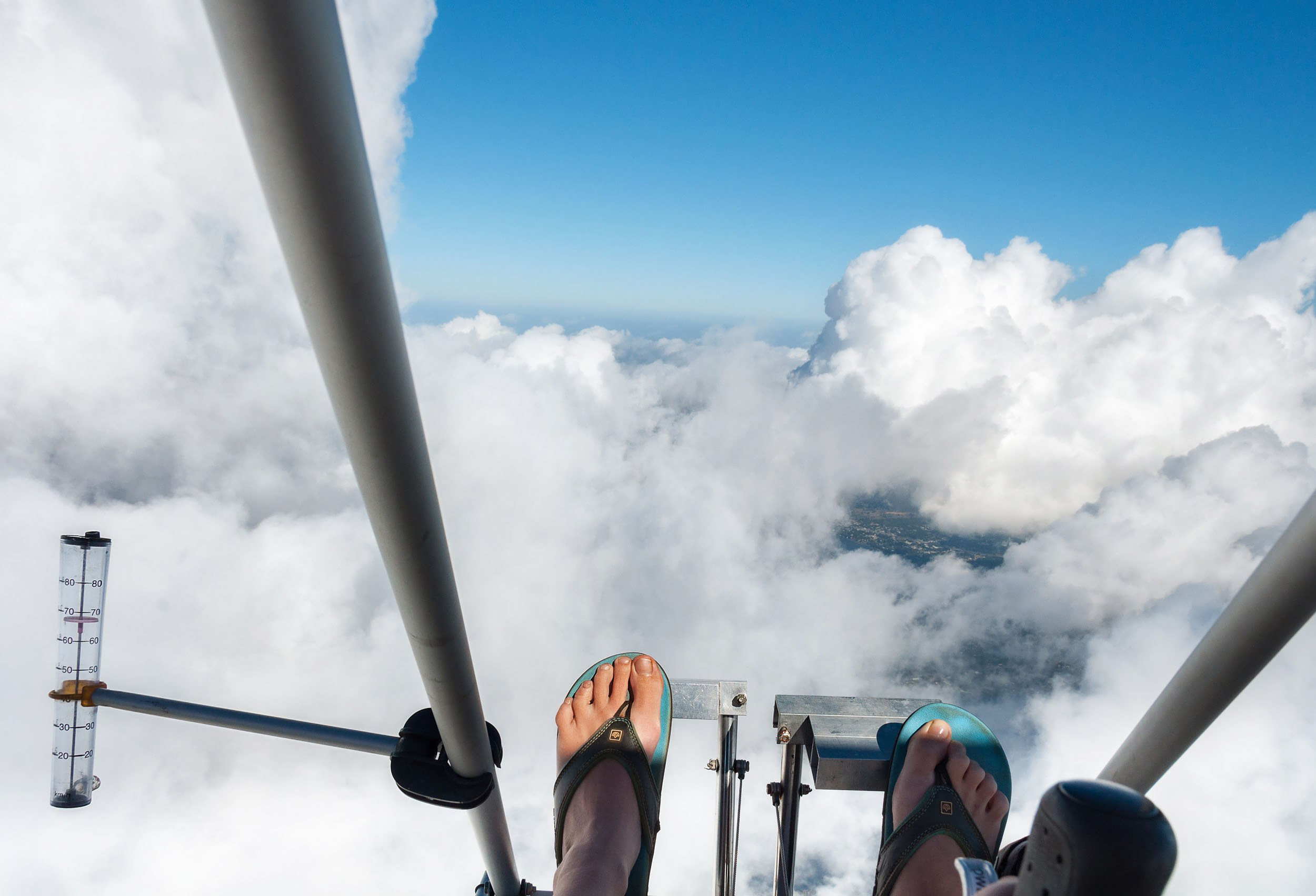
In a Cessna, the instrument panel looks much more serious and obscures half of the view. I am rather short, so even a runway in front of the airplane is only barely visible:
В Цессне же приборная панель выглядит гораздо серьезнее и закрывает половину обзора, а с моим ростом даже полосу видно так себе:
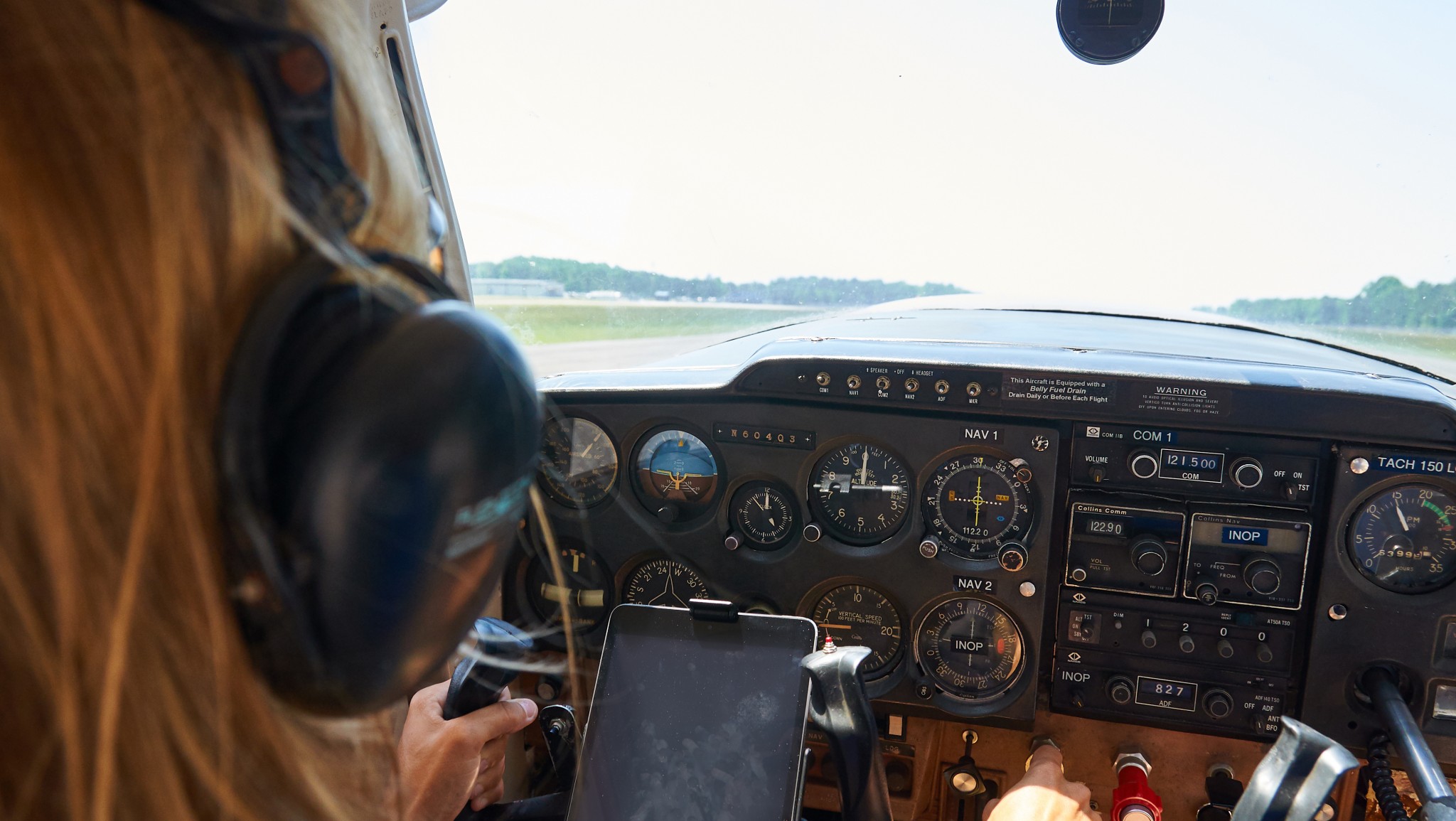
“It will take of by itself. Just give it full power and I will be here for you” — Jason said.
“Да она сама взлетит, давай газу, я рядом,” — Джейсон на английском говорит, конечно, это я сейчас перевожу.
I gave it full power. We began to roll.
Даю газу. Едем.
“Rotate!” — Jason said.
“Rotate!” — говорит Джейсон.
“What exactly does ‘rotate’ mean?” — I asked. Apparently I didn’t know this word in such a context. The closest aviation-related thing to “rotate” in my mind is a barrel roll, but that was obviously not it. Meanwhile, I softly pulled on the yoke, because I felt the plane quivering as if it wanted to take off.
“Что значит Rotate?” — не понимаю я английский (ну не “бочка” же, в конце концов), но ручку на себя потихонечку тяну, ибо самолёт уж очень как-то сильно трясется.
“You did all right!” — Jason said when we were already a couple of hundred feet high. This is how I learned what Rotate means in this context.
“Всё правильно сделала!” — говорит Джейсон уже на паре сотен футов высоты. Так я поняла, что значило Rotate в том контексте.
Then we flew and did all the basic and even a few non-basic maneuvers, and then we landed the plane. Landing a Cessna turned out to be similar to the take off: the airplane somehow seemed to want to land all by itself. I was looking at Jason’s arms and legs now and then — he really didn’t touch anything. Honestly, this Cessna plane is pretty simple to fly.
Дальше мы полетели делать все базовые и небазовые манёвры. А потом садить самолёт. Садили также, как взлетали, то есть самолёт как-то сам садился. Я посматривала за руками и ногами Джейсона — он правда ничего не трогал. Очень очень простой этот самолёт Цессна, честное слово.
But you will have a normal demo flight, do not worry!
Но у вас будет нормальный демонстрационный полёт, вы не беспокойтесь!
Pre-solo flying
Полёты до первого самостоятельного
Flight training can be divided into two major parts: before and after a student’s first solo flight.
Лётную подготовку можно условно разделить на две части: до и после самостоятельного вылета.
Before the first solo, in addition to simply piloting, a student needs to learn a large amount of various procedures so that later flights without an instructor are safe, and the student is less likely to be overwhelmed in case of an emergency.
До первого самостоятельного вылета помимо простого пилотирования студенту нужно изучить большой объем различных процедур, чтобы в дальнейшем полёты без инструктора прошли безопасно и студент не растерялся в случае нештатной ситуации.
For example, by the time of the first solo flight, a student has to be able not only to fly the traffic pattern, correctly depart and return from the practice area, conduct radio communications and confidently land the plane in various conditions, but also correctly respond to all sorts of simulated failures at different stages of the flight. They must also be familiar with all types of stalls, side slips and forward slips, crosswind landings, go-arounds and even ground reference maneuvers.
То есть, к моменту первого вылета студент умеет не только летать по коробочке и в зону, вести радиообмен и уверенно сажать самолёт, но и отрабатывать всяческие отказы на разных этапах полёта, все виды сваливаний, скольжение на посадочной глиссаде, взлёт и посадку с боковым ветром, уходы на второй круг и даже манёвры по наземным ориентирам.
All this practice is not in vain! Jason told us a story of how one of his students experienced a radio failure on his first solo flight. In order to land at the airport with a control tower, the student in a panic had to remember all combinations of light signals from the control tower and the entire procedure of behavior in traffic in case of radio communication failure. And this was not the most unusual first solo flight in the history of aviation, I am sure!
И не зря! Джейсон рассказывал, как у одного его студента пропала радиосвязь в первом самостоятельном полёте. Чтобы зайти на посадку в аэропорт с вышкой, студенту пришлось в панике вспоминать все комбинации сигнальных фонарей вышки и всю процедуру поведения в трафике при отказе радиосвязи. И это всяко был не самый курьезный первый полёт в истории авиации!
So, dear students, do not rush and do not be discouraged if you are not allowed to fly on your own as soon as you’d wish, even though you already know how to take off and land perfectly! Good take-offs and landings are not the only important things on the way to solo flights!
Так что, уважаемые студенты, не торопите события и не расстраивайтесь, если вас не пускают летать самостоятельно, хоть вы уже умеете прекрасно взлетать и садиться! Хорошие взлеты и посадки — не главное в допуске к самостоятельным полетам!
But what a wonderful stage of training this is! To finally have “danced the skies on laughter-silvered wings” and felt the thrill of your first landings, and the joy of controlling the wing! Some pilots become instructors later, only to feel the happiness of the first flights through their students.
Зато какой же это прекрасный этап обучения! Укрощение мощного мотора, романтика первых посадок, радость управления крылом! Некоторые пилоты потом инструкторами становятся, лишь бы сквозь студентов ощущать счастье первых полётов.
Our flying day schedule
Как проходил наш лётный день
As I wrote in the second entry of this story, our instructor Jason was only available for a full eight hour day at a time. In order for Andrey and I to make the best use of this, we would each take a flight with him before lunch, then follow with a flight again for each of us after lunch.
Как я писала во второй части этого повествования, наша договоренность с инструктором Джейсоном заключалась в том, что мы “выкупаем” его на восьмичасовой рабочий день, и летаем с Андрюхой по очереди до обеда и потом по очереди после обеда.
Usually this meant that we would arrive a little earlier than the appointed time and conduct a pre-flight inspection of the aircraft by ourselves (always using checklists!). Then Jason would come, have a preflight talk, and then fly for an hour and a half with each of us. Then we’d debrief and go for lunch (usually a Subway sandwich), more often than not continuing to talk about things we needed to learn. Then he’d fly with each of us one more time for an hour and a half or so. Since Andrey and I took turns like this, we each had time to relax in between the sessions. I don’t know how Jason managed to last the full day without rest. Probably from experience.
Обычно это означало, что мы приезжали чуть раньше назначенного времени и сами проводили предполётный осмотр самолёта (обязательно по чек-листам!). Потом приезжал инструктор, проводил предполётную и летал с каждым из нас по часу-полтора. Потом разбор полётов и обед (обычно сэндвич в Сабвэе), как правило не прекращая обсуждать полёты. Потом снова по полёту с каждым из нас по часу-полтора. Мы летали по очереди и успевали отдыхать между сессиями. Как выдерживал Джейсон — не знаю. Опыт.
One of the unexpected benefits of this approach was that Andrey and I got to listen in on each other’s pre-briefing and debriefing. This gave both of us a bit of a kind of extra free ground instruction. Hearing things twice never seems to hurt.
Один из плюсов такого подхода — возможность слушать предполётные и разборы полётов друг друга. Очень помогает лучше разбираться с возможными ошибками.
During the flight training, all flights are recorded in the log book. While your instructor is flying with you, he is the Pilot In Command, so he signs the logbook entry for each flight, indicating the number of his certificate and the type of exercise performed in accordance with the curriculum used (our instructor used Jeppesen Private Pilot Training Syllabus).
В процессе обучения все полёты записываются в лётную книжку. Пока студент летает с инструктором, КВСом (командиром воздушного судна) является инструктор, так что он расписывается за каждый полёт, указывая номер своего сертификата и номер отрабатываемого упражнения в соответствии с используемой учебной программой (наш инструктор использовал Jeppesen Private Pilot Training Syllabus).
Andrey and I each had around ten hours airtime in the Cessna 150 when Jason decided we were ready for our first solo flight in this plane and at an airport with a control tower.
На момент нашей готовности к самостоятельным вылетам на Цессне у нас с Андрюхой было по десять часов налёта.
Pre-solo written exam
Экзамен перед первым самостоятельным полётом
Before a student is allowed to fly his first solo, they must pass a small written exam given by their instructor. Examples of such exams can be found on the Internet as “Pre-solo written exam” [see sidebar] but your instructor will have his own unique questionnaire covering the necessary topics.
Перед тем, как студента выпустят в первый полёт, он должен сдать небольшой письменный экзамен своему инструктору. Примеры таких экзаменов можно найти в интернете по запросу “Pre-solo written exam”, но у вашего инструктора будет свой вариант, покрывающий необходимые темы.
If, during the exam, it turns out that you don’t remember something, most likely your instructor will simply refresh your memory and then tell you about it with even more in detail. You won’t really fail and you don’t have to be nervous. This test seems to be actually just a form of extra instruction and a last minute confirmation of your abilities as opposed to any true pass/fail evaluation.
Если в процессе экзамена окажется, что вы какую-то мелочь не знаете или не помните, инструктор вам это просто поподробнее расскажет, так что сильно боятся этого экзамена не стоит.
First solo
Первый самостоятельный
The first solo flight on a real plane at a controlled airport is exciting, even when you are already used to flying ultralights and hang gliders. When it’s the very first solo flight of your life, it will be remembered for a lifetime.
Первый самостоятельный полёт на настоящем самолёте в настоящем аэропорту волнителен, даже когда раньше уже летал на маленьких самолетиках и дельтапланах. А самый-пресамый первый самостоятельный полёт запоминается на всю жизнь.
For me, I have three memorable solos worthy of a unique page in my life. The first was my solo in a hang glider in 2002, though it actually coincides with my very first flight in a hang glider: this is how most students learned to fly a hang glider; from a small hill, basically solo flying right from the start! Next was my first solo in a Dragonfly (which I had never anticipated doing) in 2009 and now, in 2017, there is my first solo in what some might call a “real” airplane; this Cessna.
У меня было три первых самостоятельных полёта, как три вехи в жизни. Самый первый самостоятельный полёт был на дельтаплане в 2002 году. Он был одновременно первым полётом на дельтаплане вообще: в большинстве своём дельтапланеристы сразу учатся летать самостоятельно, делая коротенькие невысокие подлёты по несколько секунд. В 2009 году был мой первый самостоятельный полёт на Драгонфлае, моём первом моторном крыле. А в 2017 году случился мой первый соло-полёт на “настоящем” самолёте, Цессне.
Our first solos in the Cessna happened at the Leesburg airport (KLEE), although we were based at the smaller airport nearby called Apopka (X04). In Leesburg, the runways are longer and wider, and they have a control tower there, so our instructor felt it was safer there.
Наши первые самостоятельные на Цессне мы отлетали в международном аэропорту Лисбурга (KLEE), хотя базировались мы в аэропорту со смешным названием Апопка (X04). В Лисбурге полосы подлиннее и вышка есть, поэтому нашему инструктору здесь было спокойнее за нас.
For our first solos, we flew patterns and made three landings. It felt nice being in the plane alone. Jason observed us from below and pretended not to worry at all.
В качестве первых самостоятельных мы летали по коробочке и совершили по три посадки. Было приятно находится в самолете в одиночестве. Джейсон следил за нами снизу и делал вид, что совсем не волнуется.
Most of all I remember how much easier it was for this small Cessna 150 to gain altitude without the second passenger!
Больше всего запомнилось, насколько легче Цессне 150-й набирать высоту без пассажира!
This is how we became solo pilots.
Так мы стали самостоятельными пилотами (опять).
By the way, as I wrote in the third part of my story, for the solo flying it is necessary to have:
Кстати, как я писала в третьей части своего повествования, для соло-полетов обязательно иметь:
- Student Pilot License
- At least a 3rd class medical
- Solo endorsement in the log book
- студенческую лицензию
- пройденную медкомиссию как минимум третьего класса
- допуск к самостоятельным полётам в лётной книжке.
A solo endorsement is valid for 90 days, after which a student must get a new one (if he or she didn’t get a PPL during those three months, of course).
Допуск к самостоятельным полётам (так называемый Solo endorsement) действует 90 дней, по истечении которых надо получать новый (если не успеешь за три месяца получить лицензию пилота).
This endorsement is not enough to fly into Class B airspace (the airspace of especially large airports) or to fly further than 25 nautical miles from your base of operations — these require separate endorsements.
Этого допуска недостаточно, чтобы летать в воздушное пространство класса B (пространство особо крупных аэропортов) и чтобы летать маршруты дальше 25 морских миль — для этого нужны отдельные допуски.
In addition to those limitations, the student pilot is prohibited from:
Помимо этого пилоту-студенту запрещается:
- Having passengers on board!
- Flying an airplane of a different model or at a different airport than specified in the endorsement
- Flying with visibility less than 3 miles
- Flying above the clouds without ground reference
- Flying to other countries
- Being a co-pilot
- Making money by flying
- Well, not obeying the instructor, who may issue additional restrictions.
- Иметь пассажиров на борту!
- Летать на самолете другого типа или в другом аэропорту, чем указано в допуске
- Летать с видимостью менее 3 миль
- Летать над облаками без видимости земли
- Летать в другие страны
- Быть вторым пилотом
- Зарабатывать полётами деньги
- Ну и не слушаться инструктора, который может выдать дополнительные ограничения.
All of this is logical, but we were a little sad that we couldn’t take a passenger on board — otherwise Andrey and I would fly together. Instead, I took my Kilkanda rabbit with me:
Всё логично, но немного грустно, что нельзя брать пассажира — а то мы бы с Андрюхой вместе летали. А так я возила с собой Килканду:
Dual/Solo local area
Локальные полёты с инструктором и без
After our first solo flights, we began to alternate flying with Jason and flying solo both in the pattern and in the nearby practice area (a large unpopulated area adjacent to the airport). Jason introduced us to night flying and an increased amount of instrument training. To simulate instrument conditions, we had to wear the so-called plastic hood which didn’t let us see anything except instruments. Also, Jason reduced the tolerances for variances in speed and altitude in performing other maneuvers, preparing us for the exams.
После получения допуска к самостоятельным полётам мы начали чередовать полёты с инструктором и самостоятельные полёты по коробочке и в зону. Джейсон подключил к тренировкам ночные полёты и полёты по приборам (для полётов по приборам нам приходилось одевать так называемый пластиковый “козырёк”, под которым не видно ничего, кроме приборов) и ужесточил требования к выполнению остальных манёвров.
But the most fun, of course, was for me and Andrey to come together to the airport for the whole day and fly on our own, taking turns, perfecting different types of maneuvers and landings, then finishing our busy day and all the flying at sunset. In the lake region of Florida sunsets are very beautiful from the air.
Но веселее всего, конечно, было приезжать с Андрюхой на целый день в аэропорт и летать по очереди самостоятельно, оттачивая разные виды манёвров и посадок. И завершать полёты на закате — в озерном краю Флориды это очень красиво.
The only problem with finishing the flying at sunset was being eaten by mosquitos while you refueled and secured the aircraft!
Комары только после заката съедают!
Dual Cross-country
Маршруты с инструктором
When we had about 18 hours airtime each, Jason introduced us to our first cross country flying. The first route was from Apopka (X04) to Crystal River (KCGC) and back, about 50 miles one way.
Когда налёт у каждого из нас составлял около 18 часов, мы с Джейсоном полетели в наш первый маршрут Apopka (X04) -> Crystal River (KCGC) и обратно — это примерно 50 миль в одну сторону.
I have to say, this is completely different from hang gliding cross country flying, when we
Скажу сразу, это совсем не похоже на дельтапланерные маршруты, в которых ты
- constantly work on either climbing or conserving altitude;
- fly from cloud to cloud and deviate from the route as much as we want.
- постоянно работаешь над набором или реализацией высоты;
- летаешь от облачка к облачку и отклоняешься от маршрута, сколько захочешь.
Flying XC by plane seemed significantly more boring, as if driving a car through the sky, while someone would constantly chit-chat on the radio. Although I must say that a year after we had already earned our PPL’s and were flying from Florida to the First Flight airport in North Carolina along the coast from sunrise to sunset, we enjoyed it immensely. It was beautiful and interesting to have so much variable landscape passing under our belly.
Летать маршруты на самолёте показалось ощутимо скучнее. Словно ведешь машину по небу, а кто-то постоянно талдычит в радио. Хотя, через год, когда мы летали из Флориды в знаменитый First Flight аэропорт в Северной Каролине вдоль побережья, нам понравилось, было красиво и интересно пропускать такие расстояния под пузом.
During the XC training, however, there was no time to get bored. Before the flight, a student has to fill out the Flight Planning sheets using a map, weather forecasts, and an E6b flight computer to plot a waypoint every ten miles or so along the route. Then, for each waypoint, we had to calculate the exact time of arrival and the amount of fuel burned. Once finished with this, we’d add up the fuel expected to be consumed to make sure we would have a sufficient safety reserve left in our fuel tanks.
Впрочем, во время обучения маршрутным полётам скучать было некогда. Перед маршрутом тщательно рассчитывается маршрутный лист (с помощью карты, прогнозов погоды и навигационной линейки!). Каждые 10 миль маршрута ставится поворотный пункт, и для каждого такого пункта вычисляется точное время прибытия и количество израсходованного топлива.
While en route, the student then needs to visually search for those waypoints every 10 miles (we weren’t allowed to use a GPS when training), and then note any discrepancy between the planned and actual arrival time for each point (which often does not exactly coincide, because the weather forecast of the winds aloft is not 100% accurate). Based on any discrepancy, they then must recalculate the arrival time to the next point. This would allow you to notice if the actual winds aloft deviated enough from what was forecasted to prevent you from having enough fuel to reach your destination. If so, then you could divert to an alternative airport (already included in your flight planning) while the engine was still running! All this while listening and responding to the radar service, traffic controllers and to the constantly chatting and distracting instructor who is doing it on purpose, training you by bringing as much controlled stress to your life as possible!
А потом, в полёте, нужно искать зрительно эти поворотные пункты каждые 10 миль (GPS-ом при обучении пользоваться нельзя), сверять с планом время прилёта на каждую точку (которое часто не совпадает, потому что прогноз погоды недостаточно точен) и пересчитывать время прилёта на следующий пункт (это позволяет заметить, если ветер изменился настолько, что топлива до конечного пункта маршрута может не хватить, — в таком случае маршрут перестраивается). И всё это время слушать и отвечать радарному сервису и болтающему и отвлекающему инструктору, который просто изо всех сил старается привнести в твою жизнь как можно больше контролируемого стресса!
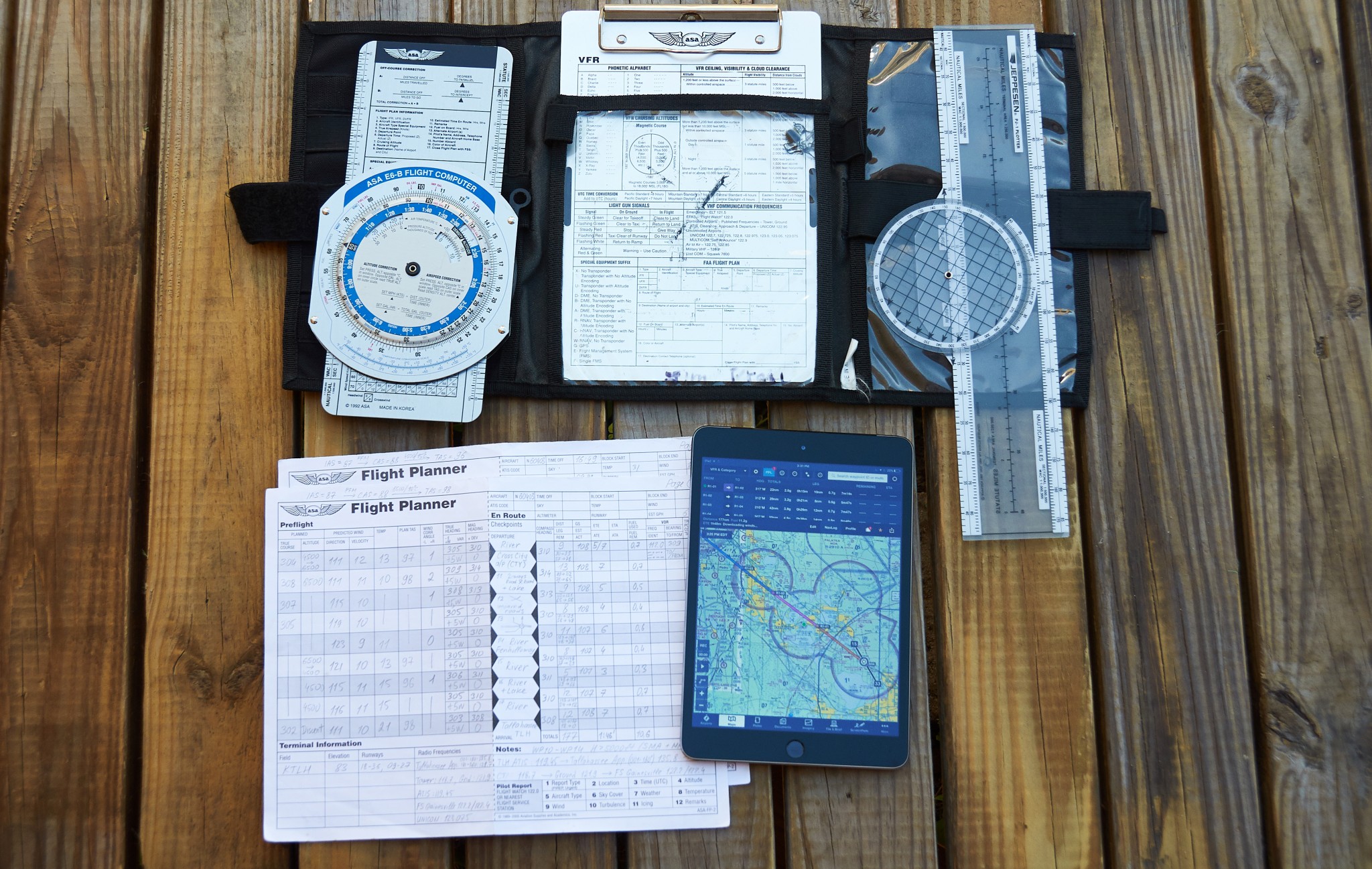
After Jason flew two more fifty-mile cross country flights with us during the day and one at night, we were allowed to do our solo cross countries!
После того, как Джейсон слетал с нами еще по два пятидесятимильных маршрута днём и один ночью, мы были допущены к самостоятельным маршрутным полётам.
How good it was to finally fly solo cross country!
Как же хорошо было наконец полететь в самостоятельный маршрут!
Just a few more words about night cross country and night flying in general. On one hand, this is scary: you can hardly see any potential landing sites. In the event of an engine failure, the chances of a good landing are much lower, so you fly higher so that there is more time to deal with and possibly solve any problems as well as a greater chance of reaching any airport nearby.
Добавлю только по поводу ночных маршрутов и ночных полётов вообще. С одной стороны это страшновато: потенциальные посадочные посадки видно плохо, в случае отказа двигателя шансов хорошо приземлиться существенно меньше, стараешься летать повыше, чтобы было больше шансов долететь до аэропорта.
On the other hand, it is breathtakingly beautiful. I was particularly fascinated to learn about how any pilot with a radio can turn on the lights of a whole airport by themselves!
Зато с другой стороны это дух захватывает как красиво. Особенно меня восхищало самостоятельное включение огней целого аэропорта!!!
There are many airports all over Florida. Some of them have lights turned on all night, but many airports do not, in order to save electricity. Pilots can turn those lights on themselves when they want to land or if they fly by and want to better determine their location. In order to do this, a pilot has to merely push the call button of his radio on the airport frequency several times.
В общем, аэропортов во Флориде много, у большинства есть подсветка ночью, но у многих аэропортов (у которых вышка работает не круглосуточно) подсветка не горит всё время, чтобы не тратить зря электричество. Её включают пилоты сами, когда хотят сесть или если летят мимо и хотят лучше определить своё местоположение. Для этого на частоте аэродрома надо несколько раз нажать кнопку вызова на рации.
Believe me, it is a fantastic feeling when you fly somewhere near the airport, but everything is dark and you can’t see the runways but you know they should be here somewhere. Then you click the call button three times, and right in front of your eyes the multi-colored lights of the whole airport and runways and taxiways suddenly light up, stretching over a large area, like a huge Christmas tree. Very exciting! You can even select the brightness of the lights. Five clicks on the airport frequency is brighter. Seven clicks is the brightest.
И это фантастическое чувство, когда летишь и знаешь, что ну вот, где-то же уже рядом должен быть аэропорт, и нажимаешь три раза на кнопку вызова, и прямо перед тобой вдруг загораются разноцветные огни целого аэропорта, простираясь на большую площадь, как огромная новогодняя ёлка. Очень здорово!
Solo cross country
Самостоятельные маршруты
But let’s go back to the solo cross country flying. As I mentioned above, for each solo flight further than 25 miles from your base of operations, there must be a separate endorsement in your log book from your instructor. You analyze the weather, place all the waypoints, calculate times and petrol required. Then your instructor checks over your planning and signs everything before you depart.
Но вернемся к самостоятельным маршрутам. Как я упоминала выше, для каждого самостоятельного маршрутного полета дальностью более 25 миль требуется отдельный допуск в лётной книжке от инструктора. Вы сами анализируете погоду, рассчитываете все поворотные точки маршрута и заправки, но инструктор перед вылетом всё проверяет и расписывается.
All in all, a cross-country flight comes down to navigation and radio communications.
По большому счету, маршрутный полёт сводится к навигации и радиосвязи.
Navigation
Навигация
The navigation part in the US is pretty easy. In real life pilots flying XC actively use a built-in GPS navigation (if they have any) or the ForeFlight application on iPads (I wrote more about this in the fourth entry of this story). ForeFlight is very convenient: it contains all the information about any airport (all frequencies, runway lengths, approach patterns, etc.), and all weather forecasts in a convenient form. It also includes topography maps and airspaces. It is a gps-navigator in the sky and you can’t get lost with it!
“Навигировать” в США легко. В реальной жизни в маршрутных полетах пилоты активно пользуются встроенной gps-навигацией (если есть) и ForeFlight приложением на айпадах (я подробнее писала про него в четвертой части). Приложение очень удобное — в нем сразу и вся информация по аэродромам — все частоты, длины полос, схемы заходов и т.д. и т.п., — и все прогнозы погоды в удобном виде, и карты местности, и воздушные пространства, и навигация, и много чего еще. Не заблудишься!
Every pilot should be able to navigate if their GPS and/or iPads fail, therefore the exam must be passed without using a GPS or ForeFlight. It must be done in the old fashion way: calculations, navigational rulers and an E6b flight computer, with visual searches for waypoints. One can also use VOR and ADF stations for navigation, using the instruments included in almost all general aviation aircraft (although a functional ADF instrument is found less and less).
Но каждый пилот должен уметь навигировать даже если его gps и/или iPad сломается, поэтому экзамен надо сдавать без gps и без ForeFlight, а по старинке — расчеты, “логарифмическая линейка”, визуальный поиск ППМ, курсовой индикатор VOR, радиокомпас ADF и т.п.
Therefore, training flights are also conducted using such technically simple methods. Before our solo cross country, however, Jason still showed us how to use ForeFlight, just in case we got lost, I suppose.
Поэтому и учебные полеты все проводятся вот такими вот технически простыми методами. Хотя перед самостоятельными маршрутами Джейсон всё же показал нам, как пользоваться ForeFlight’ом, на всякий случай.
On top of that, a student should be able to read the airspace map really well. Although it looks rather complicated for an unprepared viewer, all these designations and representations of air space is the easiest topic in the PPL theory. The symbols used and the rules applied are simple, logical and extremely clear.
Плюс нужно хорошо читать карту воздушного пространства. И хотя для неподготовленного зрителя она выглядит довольно сложно, на самом деле все эти обозначения и воздушные пространства — самая простая тема в теории на PPL. Правила просты, логичны и предельно понятны.
For example, when flying from Leesburg (KLEE) down to Plant City Airport (KPCM), located under the Tampa airspace, we knew in advance how and where to “dive” under the upside-down wedding cake shape of a Class B airspace, at what altitude and where to fly, how to approach the airport, and what frequencies to use to contact the radar control and the other traffic around us.
Итого, подлетая, например, к аэропорту Plant City, находящемуся в пространстве Тампы, ты заранее знаешь, как и где “нырнуть” под пространство B, на какой высоте где пройти, как зайти на посадку, на какой частоте связаться с радарным контролем, а на какой — с вышкой.
Radio communications
Радиосвязь
Yes, for a non-native English speaker, radio communications can be rather difficult part of their XC flights.
Да, студенту, для которого английский — не родной язык, радиосвязь может оказаться довольно сложной частью маршрутных полетов.
Overall, you have to communicate by radio with:
По большому счету, по радиосвязи приходится разговаривать с:
- Control Tower and/or other airplanes in the traffic
- Radar Traffic Information Service, which provides an optional VFR flight-following service and allows you to enter into some airspaces.
- FSS or a Flight Service Station is where you submit flight plans (for VFR flying this is also optional), and where you can also find out the weather, NOTAMs, submit pilot reports, etc.
- Вышкой аэропорта и/или самолётами в зоне/на круге
- Радарным контролем — который разрешает влёт в некоторые воздушные пространства и который ведет по маршруту (хотя это обязательно только если лететь по IFR, а не VFR)
- FSS — сервис, в который надо подавать полётный план (при полете по VFR это опционально), а также можно узнавать погоду, НОТАМы, подавать свои отчеты и погоде и т.п.
Communicating with the control tower is relatively simple. The air traffic controllers at the tower most often try to help students if things are not too busy. You can say “I am a foreign student pilot, say again, please”, and the tower will most likely repeat everything slower. Trying to communicate in areas of heavy traffic could be different. There are many foreign students learning to fly in the States (including us, of course), and for a Russian it is often very hard to understand the accents of some Asian students. However, it is also difficult for Americans to understand all of us, therefore, everyone tries to be tolerant of each other and will often ask you to repeat the transmission, if needed.
С вышкой разговаривать относительно просто. Вышка чаще всего старается помочь студенту. Всегда можно сказать “I am a foreign student pilot, say again, please”, да и говорит вышка обычно медленнее и понятнее.
Самолёты на круге бывают разные. Иностранных студентов много, и акцент некоторых азиатских студентов нашему русскому уху распознать сложно. Впрочем, американцам тоже трудно нас всех понимать, поэтому все терпимо относятся друг к другу и переспрашивают, если что.
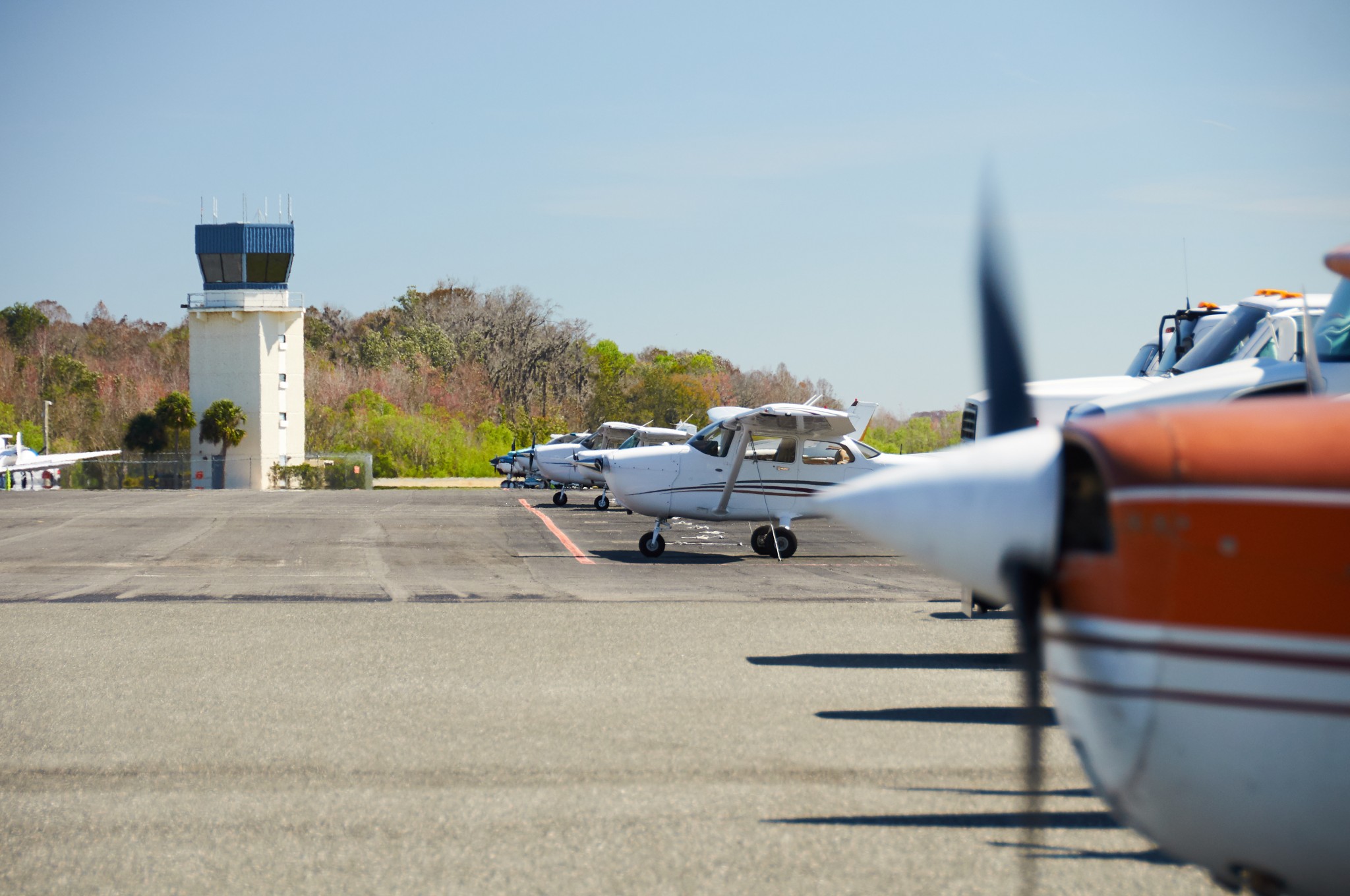
Radar service is more complicated. They are only a few centers responsible for this service, they are spread over large areas, and speak with a large (very large!) number of aircraft, including lots of passenger and cargo airlines. For example, during our flight training we flew in the areas of the radar services of Orlando, Jacksonville and Tampa.
С радарным сервисом сложнее. Их мало, они ответственны за большие зоны и говорят с большим (очень большим!) количеством самолетов, в том числе со всеми пассажирскими лайнерами, коих миллион. Например, в наших учебных маршрутах мы летали в зонах действия радарных сервисов Орландо, Джексонвиля и Тампы.
It works like this:
Выглядит это так:
- you take off, select the frequency of the nearest radar service and wait for the smallest pause in the endless talking just to insert the name of the ATC you are talking to and your call sign (ours was Cessna-Six-Zero-Four-Zero-Three, which is our aircraft type and registration number). And nothing more. And you wait. After some time of endless broadcast and conversations between the controller and other planes (sometimes for a long time), you suddenly hear them respond to your call sign (it’s important not to miss it!).
- Then you need to quickly tell the airport codes of where you are and where you want to go, and that you are VFR at which altitude. If it all goes well, the radar controller will respond with “Squawk” and four digits.
- You must set those digits into your transponder to be identified on their radar screen.
- After some time the controller will confirm that they see you.
- In flight they will contact you every time another plane flies not far from you, giving you the distance and bearing to make sure you see each other. Also, every step you take is now under their control: you can’t turn for some sightseeing or change your altitude without a request.
- When you fly up to the border of another radar control area, you will either be “handed over” to the new traffic controller (if you behaved well and they are not too busy or lazy), or “terminated” and you will have to contact the new radar service yourself.
- взлетаешь, выставляешь частоту ближайшего радарного сервиса и ждешь, когда будет хотя бы секундная пауза, чтобы просто вставить позывной сервиса и свой позывной (у нас это было Cessna-November-Six-Zero-Four-Zero-Three (тип и регистрационный номер самолета). И ничего больше. Просто позывной. И ждешь. Через какое-то время бесконечного эфира и разговоров контроллера с другими самолетами (иногда долгое время) ты вдруг слышишь свой позывной (важно не пропустить!).
- Тут надо быстро сказать код аэродрома, откуда летишь, код аэродрома, куда летишь, VFR или IFR (у нас VFR пока, конечно), высоту. Если все понятно, в ответ тебе говорят “Sqwauk” и четыре цифры.
- Ты должен выставить их у себя на транспондере(чтобы тебя идентифицировали на радаре).
- Через какое-то время тебе подтвердят, что тебя видят.
- В дальнейшем к тебе будут обращаться каждый раз, когда у тебя в зоне видимости может пролетать другой самолет, иногда будут разводить с другими самолетами. В остальном — каждый твой шаг под контролем, в сторону не сверни, высоту без заявки не поменяй.
- Когда подлетишь к границе с зоной другого радарного контроля, тебя либо “передадут” новому контролю (если ты вел себя хорошо и им не лень), либо “затерминэйтят” и связывайся с новым радаром сам.
This is if everything goes well. Often something goes, well, not according to plan. They didn’t identify you on their radar screen or they’ll ask you for your location (and you must already instantly know the nearest major airport or recognizable landmark with which to respond) or ask you to press the IDENT button on your transponder, which momentarily makes your radar return on their screen particularly large. They may tell you to change your altitude or you may want to change it and would have to ask permission. They may ask if you can confirm visual contact with an airplane that you just can’t find in the air. All those questions are simple, but they are usually said at such a frantic speed that a foreigner and a beginner XC pilot may not understand.
Но это всё в идеале. Часто идет что-нибудь да не по плану. Не распознали тебе на радарной карте. Спрашивают местоположение (и ты должен быть готов назвать код ближайшего аэропорта или узнаваемый ориентир). Или просят нажать кнопку IDENT на транспондере — это делает твою «иконку» на их радарном экране крупнее. Могут попросить занять какую-то высоту. Или тебе хочется занять другую высоту. Спрашивают, подтверждаешь ли ты визуальный контакт с самолетом, который ты в упор не видишь. Все простые вопросы так-то, но говорятся они обычно с такой бешенной скоростью, что иностранец и начинающий маршрутник может долго не понимать, что он него хотят.
Radar controllers usually do not have much time to mess around with students, so they may become irritated and terminate your radar service, and suggest you fly independently, merely according to the visual flight rules and on your own (although not near as politely. Normally it’s just “Cessna 403 radar service terminated continue own navigation” and all of it said in one quickly uttered phrase which might sound like “Cssn403rdrsvctermcontownnavgtn”). I have to say, it is easier to be a female pilot: because of our rarity we are getting more attention and are usually tolerated longer.
Радарным контролям тоже обычно некогда возиться со студентами, и они могут раздраженно его “затерминэйтить” — лишить радарного сервиса и предложить лететь самостоятельно по правилам визуальных полетов (только вместо “Cessna 403 radar service terminated continue own navigation” вы услышите “Цснфорзртррдрсвстермконтоутнвгшн”). Девочкам-пилотам, мне кажется, немного проще — за редкость нас как-то любят и дольше терпят).
Anyway, if you are flying VFR outside of a B or C airspace, communication with the radar service is NOT required. We contacted them mostly just for the experience of working with ATC.
В любом случае, если летишь вне пространств B и C, связь с радаром НЕ обязательна. Мы связывались с ними только для тренировки.
Radio or phone communication with an FSS is much easier. You talk to them before and after the flight to open and close your flight plan. They are not in a big hurry, they speak slower and sometimes even seem to enjoy trying to help.
С FSS говорить по радио или по телефону (перед полетом или после полета, чтобы открыть/закрыть план) существенно проще. Они особо никуда не торопятся и стараются помочь.
There is another thing, however, to keep in mind: you should never forget to close the flight plan. When opening your flight plan, you describe your route, departure time and expected arrival time at the final destination. Upon arrival (still in the air or already on the ground; by radio or by phone) you must contact the Flight Service Station and close your flight plan within a half hour after the landing. If you don’t, after those 30 minutes have passed beyond your planned arrival, they will start calling the number you listed in your flight plan (and reprimand you). If they don’t get through, they will send out a search and rescue team (a very expensive service!)
С ними другая проблема: когда открываешь план, ты описываешь свой маршрут, время вылета и время прилета в конечный пункт маршрута. По прилету (еще в воздухе или уже на земле, по радио или по телефону) ты обязан связаться с FSS и закрыть план. Если ты этого не сделаешь в течение получаса, тебе начнут звонить по номеру, указанному в полётном плане (и делать выговор), а если не дозвонятся — за тобой отправят поисковую спасательную бригаду.
This search and rescue service is the main reason you actually put up with all the VFR flight plan hassle. It makes huge sense when you fly over a sparsely populated area or even over the desert areas of the western part of the States, for example. But often pilots forget to close their flight plans, then they don’t hear the phone call, and then they pay for an expensive rescue operation that was not needed!
Для этого и нужен план для VFR пилотов (и это имеет смысл, когда летаешь в малонаселенных пустынных районах центральных штатов, например). Но слишком часто бывают случаи, когда пилоты забывают закрывать план, потом не слышат звонка на телефон, а потом оплачивают дорогущую спасательную операцию!
We had opened flight plans mostly under the supervision of our instructor in order to practice. During our solo flights, Jason suggested we do not use this option.
Поэтому план мы открывали под присмотром инструктора один раз, потренироваться. А при самостоятельных полетах Джейсон предлагал нам не пользоваться такой опцией.
To fulfill the XC flying requirements, we flew on our own to Crystal River and back, then Plant City and back, and then the 150-mile triangle of Apopka — Plant City — Crystal River — Apopka.
Для удовлетворения маршрутных требований, мы слетали самостоятельно в Crystal River, Тампу, а потом 150 мильный треугольник Апопка — Тампа — Кристал Ривер — Апопка.
It is a beautiful route: there are many lakes in Florida, and the Plant City to Crystal River stretch runs along the coast of the Gulf of Mexico.
Летелось красиво: во Флориде много озер, а участок Тампа — Кристал Ривер идет вдоль побережья Мексиканского залива.
It was a little annoying to listen to the endless muttering of radar control (we, hang glider pilots, are used to flying in silence) and the need to approximately every ten miles recalculate the arrival time to the next point of the route. By the way, these calculations and notes are a great distraction from your diligence in the air: you can accidentally find yourself close to a gaggle of sailplanes, for example. So if you fly a sailplane, hang glider or paraglider, and you see a fast approaching plane, don’t think “of course he sees me” — it may turn out that he is looking at the flight plan sheet at that moment and making calculations…
Немного раздражало бесконечное бормотание радарного контроля (мы, дельтапланеристы, всё-таки привыкли летать в тишине) и необходимость постоянно, примерно каждые десять миль, перераcсчитывать время прибытия на следующую точку маршрута. Кстати, эти калькуляции, расчеты и записи здорово отвлекают от осмотрительности в воздухе — можно случайно обнаружить себя рядом с “паровозом” планеров, например. Так что если вы летите на безмоторном крыле и, видя приближающийся самолет, думаете “он, конечно, меня видит” — может оказаться, что он в это время смотрит в маршрутный лист и вычисляет, хватит ли ему топлива до конечной точки маршрута.
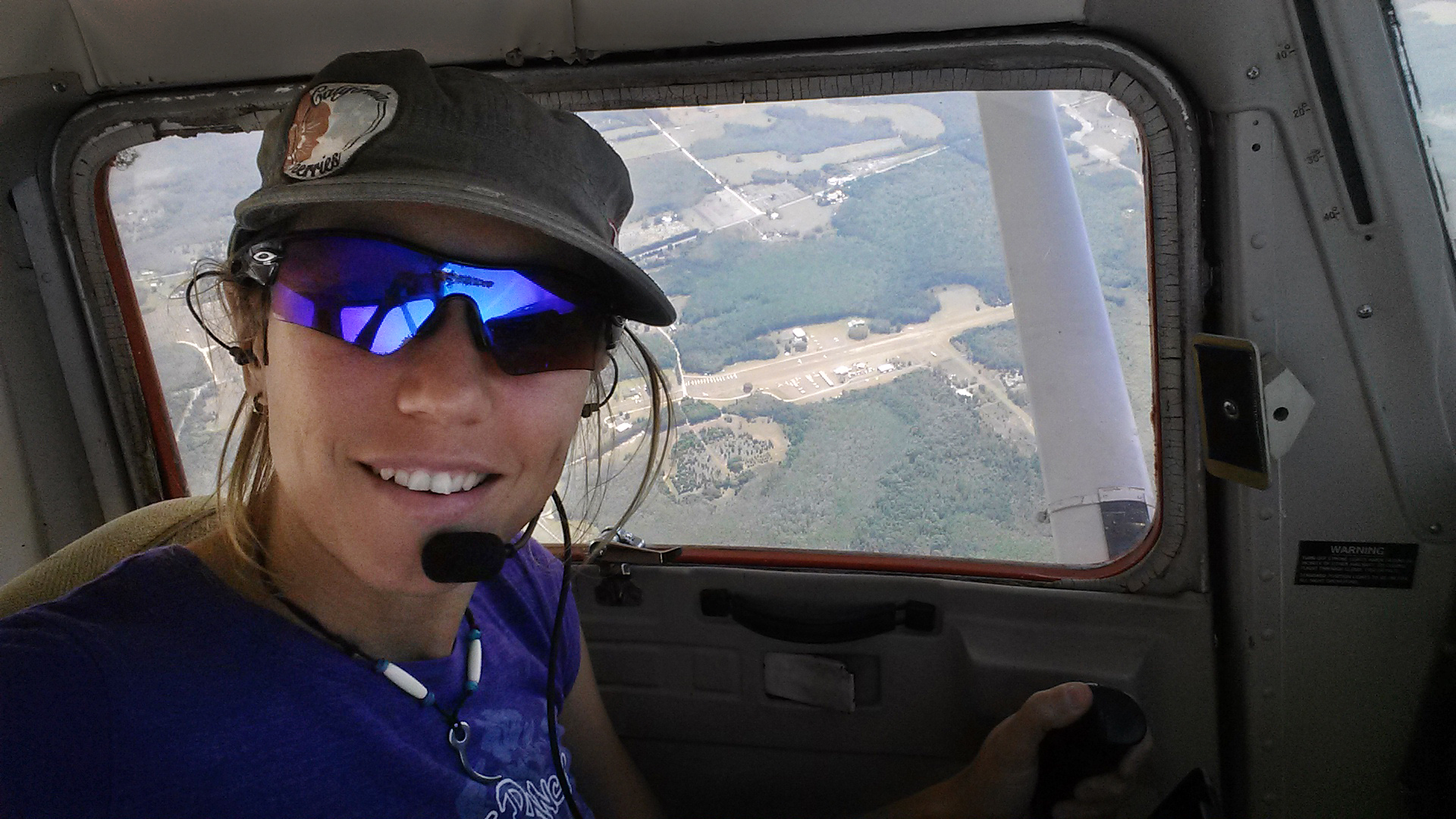
Our cross country flying passed without any incidents. It was really wonderful to fly on our own, like real pilots, over the whole peninsula of Florida, communicating with radar operators, air traffic controllers, and to fly past airports, of which there are just a million in Florida [see the sidebar]
Наши маршрутные полеты прошли без происшествий. Было очень здорово вот так, самостоятельно, по-взрослому, летать через весь полуостров, общаться с радарами, пролетать мимо аэропортов, коих во Флориде просто миллион.
In addition to the XC flying, we continued to master our skills in the practice area, training maneuvers, take-offs and landings. Sunrises, sunsets, the sky reflecting in lakes, runway lights… Romance, eh!
Помимо маршрутов, мы продолжали “оттачивать мастерство” в зоне и на круге, тренировали маневры, взлеты, посадки. Рассветы, закаты, отражение неба в озерах, огни полосы… Романтика, эх!
Our totals
Итого
In total, we had 19 flight days, including the day of the final check ride. Our first day of instruction was February 3, and the check ride took place on May 3, 2017.
Всего у нас было 19 лётных дней, считая день сдачи экзамена. При этом первый лётный день был 3 февраля, а сдача экзамена 3 мая 2017.
Yes, our flight training was stretched over three months. We really did not fly very often — obtaining a license was not the main purpose of our stay in the USA. We had other things to do and we only wanted to pass the exams before we left for Russia. So, given the excellent weather in Florida in the spring, it would have been possible to finish our training in a month if that had been our priority.
Да, наше лётное обучение было растянуто aж на три месяца, то есть летали мы не так уж и часто — получение лицензии не было главной целью нашего пребывания в США, и мы только хотели успеть сдать экзамены до нашего отъезда в Россию. Так-то учитывая отличную погоду во Флориде весной, отлетать всё можно было и за месяц.
As I wrote above, at the time of the exam I had 41.9 hours airtime, and Andrey had 42.4 hours. It included additional flying in a Piper Cherokee: we mainly wanted to get the High Performance endorsement (which allows you to fly airplanes with engines of more than 200 horsepower), but it was also interesting to fly in an airplane with a constant speed (variable pitch) propeller.
Как я писала выше, на момент экзамена я налетала 41.9 часов, а Андрей 42.4 часа. В эти часы были включены в том числе полёты на Piper Cherokee: главным образом нам хотелось заодно получить High Performance endorsement (допуск к полетам на самолетах с двигателем мощностью более 200 лошадиных сил), но также было интересно полетать на самолете с изменяемым шагом винта.
We flew the Cherokee to the very busy Sanford International Airport (SFB) which has Class C airspace around it. Although it’s not Class B airspace, they say that it’s not that much less complicated than Orlando International (MCO), which is Class B. And, by the way, landing at the large SFB airport didn’t cost anything! Taxiing a tiny Piper next to huge airliners was fun!
На Чероки мы слетали в очень нагруженный аэропорт Sanford (SFB) с пространством C вокруг. Типа как Шереметьево! Это хоть и не пространство B, но, говорят, даже в чем-то сложнее Орландо (ORL), который B. Несмотря на огромность и серьезность аэропорта, платить за посадку не надо было нисколько! Рулить на крошечном Пайпере рядом с огроменными лайнерами… весело!
How much it all costs
Сколько всё это стоит
I already mentioned the costs of the log book and the required equipment in the fourth entry of this story. I also mentioned the cost of an instructor and different training programs in the second part. Now I’ll tell you the rest.
Стоимость лётной книжки и требуемое оборудование для полётов я рассмотрела в четвертой части. Стоимость инструктора и особенности программ обучения я рассмотрела во второй части. Расскажу про остальное.
To begin with, I will mention one thing that is not always obvious to everyone and can be missed during preliminary cost calculations.
Для начала скажу одну вещь, которая не всем сразу очевидна и может быть упущена при предварительных расчётах затрат.
The number of hours you will pay your instructor for is not merely the number of hours spent with him in the sky. That is, when evaluating the costs, you can’t just blindly multiply the cost of an instructor per hour by the minimum of 23 hours required dual time!
Количество часов, за которые придётся заплатить инструктору, обычно не равно количеству часов, проведённых с ним в небе. То есть, при оценке затрат не надо слепо умножать стоимость инструктора в час на минимальные 23 часа с инструктором!
Instead, you can multiply your actual dual airtime (which will most likely be more than 23 hours!) by TWO to roughly estimate the amount of money you will eventually pay your instructor (and this is without including the payment for a separate ground school class if you need it).
Вместо этого свой фактический налёт с инструктором (который, скорее всего, будет более 23х часов) можно смело умножать на два, чтобы примерно оценить затраты на инструктора (и это без учета отдельной оплаты наземной теоретической подготовки!)
Why is that? In addition to the time in the air, your instructor will spend a lot of time on the ground teaching you how to do a pre-flight inspection of the aircraft, how to refuel it, how to build an XC-route, how to evaluate the weather, as well as discuss the exercises and maneuvers before the flight and analyze your errors after the flight, and then help you master your radio communication skills again and again. An instructor’s rate does not change whether he is teaching you on the earth or in the sky.
Почему так? Помимо времени в воздухе, инструктор будет учить делать предполётный осмотр самолёта, заправлять его, строить маршрут, оценивать погоду, будет обсуждать выполняемые упражнения до полёта и разбирать ошибки после полёта, опять и опять гонять вас по радиообмену. А ставка у инструктора не меняется от того, на земле он вас учит или в небе.
Instructor
Инструктор
In our case, we hired our instructor for an eight-hour workday each time we flew with him, which cost $350, and it didn’t matter if we spent our time together on the ground or in the sky.
В нашем случае мы нанимали инструктора на восьмичасовой рабочий день, который стоил 350 долларов, и не важно, на земле мы его проводили или в небе.
Sometimes we had extended days with a night shift — in fact, it was almost a full working day and a half. Then Jason was kind enough to take only $400 from us, although with all the time he spent on us on some longer days, he could have legitimately asked for $525.
Иногда у нас были удлиненные дни с ночной сменой — фактически это было почти полтора рабочих дня. Тогда добрый Джейсон брал с нас 400 долларов (хотя по времени, которое он нас нас тратил, он мог бы смело просить 525 долларов).
As a result, together with Andrey, we spent $3,216 for our instruction during flight training (that is, $1608 per person). This doesn’t include all the ground-based instruction we did with our instructor before we flew at all (which I wrote about in the last entry — that was $480 in total or $240 per person).
В итоге, на инструктора за время лётного обучения мы потратили 3216 долларов на двоих (то есть, 1608 долларов за одного), плюс мы ранее оплатили наземную теорию (о которой я писала в прошлой части повествования — это было 480 долларов всего или 240 долларов на человека).
In the end, the instruction part of our total expenses was exactly 50.1% of the total cost of our PPLs.
В нашем случае на инструктора ушло ровно 50.1% того, что мы потратили на весь PPL.
Fuel for the airplane
Топливо для самолёта
In addition to the instructor, we spent money on fuel for Cessna. During our training in 2017, the average cost of 100LL aviation fuel was $3.82 per gallon, and our consumption on average was 5.17 gallon per hour. Thus, the total cost of all aircraft fuel that we bought together during the training was $1701, or $850 per person.
Помимо инструктора мы тратили деньги на топливо для самолёта. Во время нашего обучения средняя стоимость авиационного топлива 100LL составляла 3.82$ за галлон, а средний расход был 5.17 галлон в час. Общая стоимость всего самолетного топлива, которое мы вдвоем купили за время обучения составила 1701 доллара, или 850 долларов на одного.
Petrol for the car
Топливо для автомобиля
We also spent about $10 for the car petrol for each trip to the airfield and back (we didn’t live that close; it was about a 40 minute drive each way). Thus, together we spent $190 ($95 per person) to get to the airfield and back. If you live at or near the airport, you will not have this expense item.
Еще мы тратили примерно 10 долларов на бензин для машины за каждую поездку на аэродром и обратно (мы жили не очень близко), итого мы на двоих еще потратили 190 долларов (95 долларов на одного) на то, чтобы добираться до аэродрома. Если вы будете жить на аэродроме или рядом, у вас не будет этой статьи расходов.
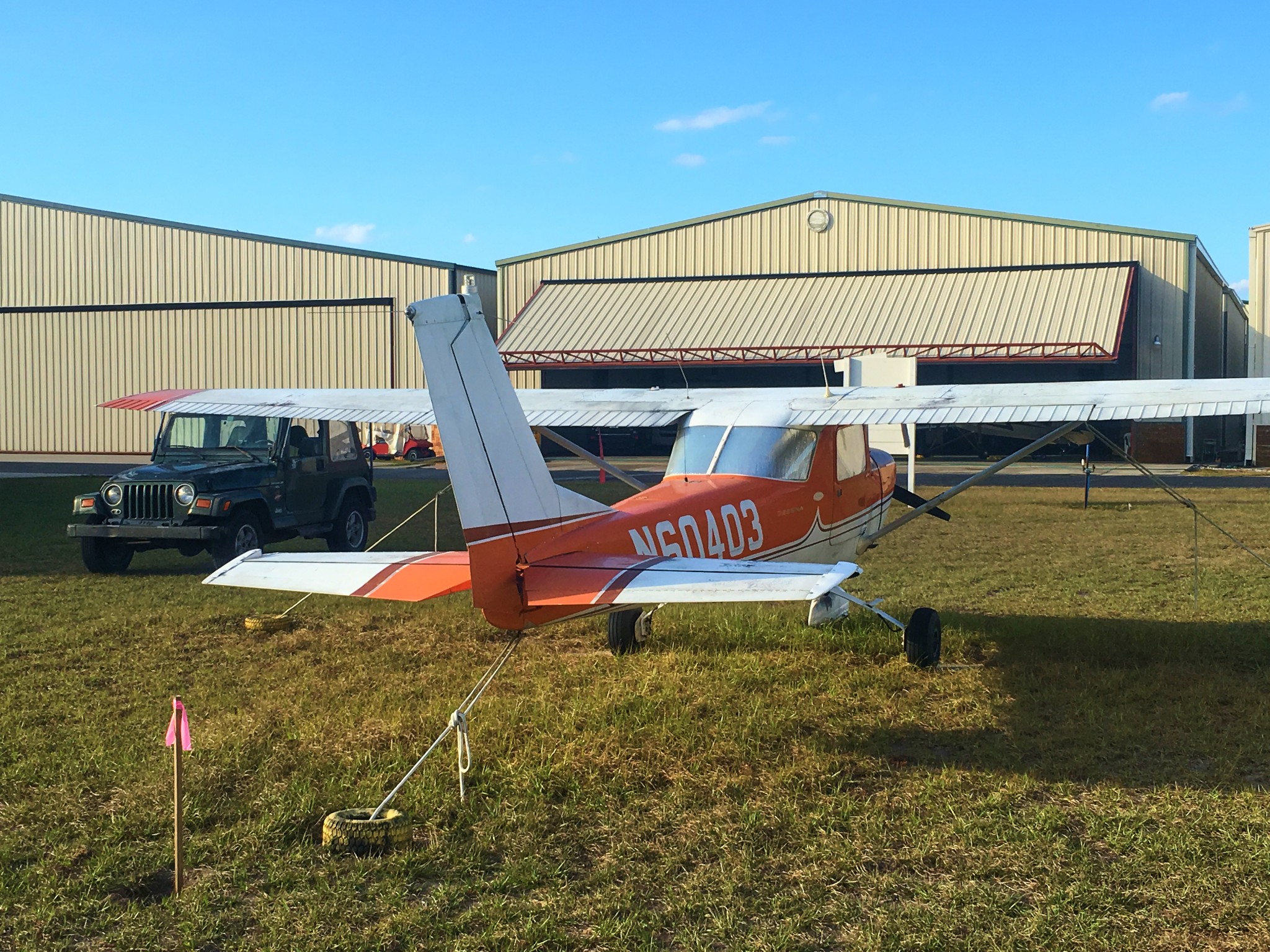
In addition to all of the above, we paid for our exams. More on that in the next post!
Помимо всего перечисленного мы заплатили за экзамены, но об этом в следующем посте!
To be continued…
Продолжение следует…
